![[Philip
Emeagwali inside the Space Shuttle.]](../../gifs/Space_Shuttle_1994.gif)

COMPUTING FLOWS AROUND SPACE SHUTTLE ORBITERS
An excerpt from Philip Emeagwali's
1989
Gordon Bell Prize Report
![[Philip
Emeagwali inside the Space Shuttle.]](../../gifs/Space_Shuttle_1994.gif)
RELATED Nature's own numbers man
Making strides in a parallel universe Both Gordon Bell Prize winners tackle oil industry problems Supercomputer produces oil reservoir simulation IEEE's Gordon Bell Prize Report
Discussions with Gordon Bell Prize Committee Upstream Interview
You said it ... This Man
RELATED |
Nearly seventy years after Leonhard Euler derived his famous
equations, in 1821, Claude L. M. H. Navier
(1785-1836) added viscous forces and rederived an improved set of
equations
then called the Navier equations. The latter equations
were rederived by Simeon-Denis Poisson in 1831
and George Gabriel Stokes (1819-1903) in 1849. These
equations, which are now called the Navier-Stokes equations,
are widely used in various fluid dynamical
applications, such as computing the flows around
turbine and compressor blades, helicopter rotors, airplanes and missiles.
Specific applications include its use by the National Aeronautics and
Space Administration (NASA) uses it to collect data that complement
those obtained from wind tunnel experiments and to compute the flow
field around a B-747 carrier aircraft transporting the Space Shuttle
Orbiter; by United Technologies Research Center to compute the
multicomponent flowfield patterns inside a centrifugal compressor.
 The space shuttle lifting off from its lauching pad. The Navier-Stokes equations are written in vectorial form as: The three scalar equations in 3.7 describe the conservation of momentum laws along the x-, y- and z- directions. Coupling Equation 3.7 to the conservation of mass and energy equations yields a system of equations with about 60 partial derivative terms to be solved at each grid point. The solution of the Navier-Stokes equations requires the specification of the conservation of mass equation, initial and boundary conditions.
 The Space Shuttle Columbia. When the fluid is compressible, the divergence of the viscous stress tensor is used in place of the viscous term where and
Alternatively, for viscous flows, the Euler's
equations 3.1 can be modified by adding
the viscous terms to it. The x-direction viscous flux
vector is
which is equivalent to The y-direction viscous flux vector is
+ Philip Emeagwali explaining the derivation of his partial differential equations. +which is equivalent to The z-direction viscous flux vector is
which is equivalent to
where
In Equation 3.12, a is the speed of sound,
where the terms of

Click on emeagwali.com for more information.
©1997. EMEAGWALI.com. All rights reserved. |